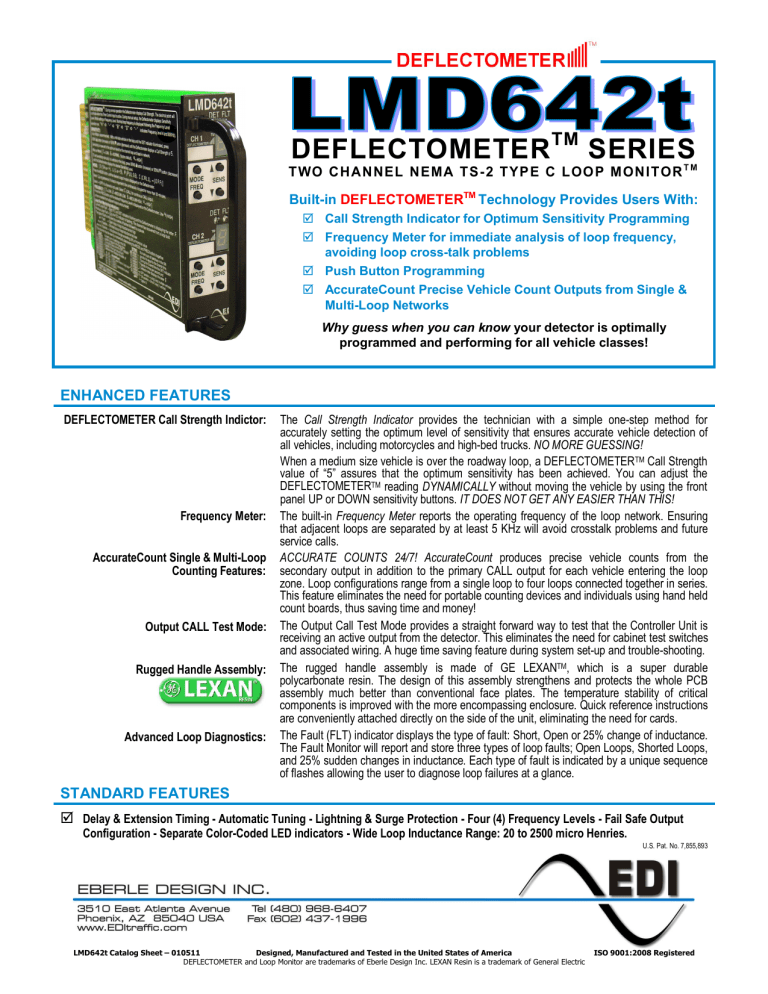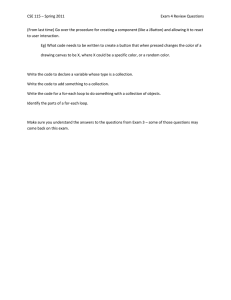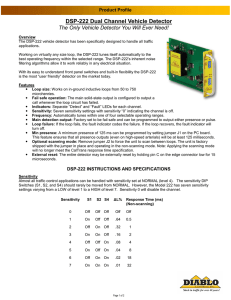DEFLECTOMETER SERIES TM
advertisement

DEFLECTOMETER TM SERIES TWO CHANNEL NEMA TS- 2 TYP E C LOO P MONITOR T M Built-in DEFLECTOMETERTM Technology Provides Users With: Call Strength Indicator for Optimum Sensitivity Programming Frequency Meter for immediate analysis of loop frequency, avoiding loop cross-talk problems Push Button Programming AccurateCount Precise Vehicle Count Outputs from Single & Multi-Loop Networks Why guess when you can know your detector is optimally programmed and performing for all vehicle classes! ENHANCED FEATURES DEFLECTOMETER Call Strength Indictor: Frequency Meter: AccurateCount Single & Multi-Loop Counting Features: Output CALL Test Mode: Rugged Handle Assembly: Advanced Loop Diagnostics: The Call Strength Indicator provides the technician with a simple one-step method for accurately setting the optimum level of sensitivity that ensures accurate vehicle detection of all vehicles, including motorcycles and high-bed trucks. NO MORE GUESSING! When a medium size vehicle is over the roadway loop, a DEFLECTOMETERTM Call Strength value of “5” assures that the optimum sensitivity has been achieved. You can adjust the DEFLECTOMETERTM reading DYNAMICALLY without moving the vehicle by using the front panel UP or DOWN sensitivity buttons. IT DOES NOT GET ANY EASIER THAN THIS! The built-in Frequency Meter reports the operating frequency of the loop network. Ensuring that adjacent loops are separated by at least 5 KHz will avoid crosstalk problems and future service calls. ACCURATE COUNTS 24/7! AccurateCount produces precise vehicle counts from the secondary output in addition to the primary CALL output for each vehicle entering the loop zone. Loop configurations range from a single loop to four loops connected together in series. This feature eliminates the need for portable counting devices and individuals using hand held count boards, thus saving time and money! The Output Call Test Mode provides a straight forward way to test that the Controller Unit is receiving an active output from the detector. This eliminates the need for cabinet test switches and associated wiring. A huge time saving feature during system set-up and trouble-shooting. The rugged handle assembly is made of GE LEXANTM, which is a super durable polycarbonate resin. The design of this assembly strengthens and protects the whole PCB assembly much better than conventional face plates. The temperature stability of critical components is improved with the more encompassing enclosure. Quick reference instructions are conveniently attached directly on the side of the unit, eliminating the need for cards. The Fault (FLT) indicator displays the type of fault: Short, Open or 25% change of inductance. The Fault Monitor will report and store three types of loop faults; Open Loops, Shorted Loops, and 25% sudden changes in inductance. Each type of fault is indicated by a unique sequence of flashes allowing the user to diagnose loop failures at a glance. STANDARD FEATURES Delay & Extension Timing - Automatic Tuning - Lightning & Surge Protection - Four (4) Frequency Levels - Fail Safe Output Configuration - Separate Color-Coded LED indicators - Wide Loop Inductance Range: 20 to 2500 micro Henries. LMD642t Catalog Sheet – 010511 Designed, Manufactured and Tested in the United States of America DEFLECTOMETER and Loop Monitor are trademarks of Eberle Design Inc. LEXAN Resin is a trademark of General Electric U.S. Pat. No. 7,855,893 ISO 9001:2008 Registered LMD642t DEFLE CTO METE R T M SE RIES TWO C H ANNEL INDU CTIVE LOO P V EH ICLE DET ECTO R SPECIFICATIONS General Characteristics Controls: Front panel push buttons allow the user to set the Sensitivity Level, Operational mode, and nominal Frequency independently on each channel. PCB mounted DIP switches allow the user to set the Delay and Extension timers and AccurateCount configuration features. Setting Sensitivity - Front Panel Push Buttons The DEFLECTOMETERTM (front panel 7-segment LED) aids in setting the DETECTOR quickly and easily to the most optimum sensitivity level to ensure the trouble-free detection of all vehicles, including motorcycles and high bed vehicles. For typical vehicles (mid-size vehicle / small pick up) utilizing properly installed roadway loops, a Call Strength of 5 displayed on the DEFLECTOMETERTM during the DETECT output period indicates an optimum sensitivity setting. For high profile vehicles (commercial trucks, 4x4’s, etc…), a Call Strength value of 4 will be optimum. For low profile vehicles (sports cars, etc…), a Call Strength value of 6 will be optimum. Adjusting sensitivity using the DEFLECTOMETERTM (recommended): The DEFLECTOMETERTM should read zero (0) with no vehicle over the roadway loop. When a typical mid-sized vehicle is completely in the detection zone (DET indicator On), the Call Strength value should be adjusted up or down until the DEFLECTOMETERTM displays the desired optimum value of 5 (or 4 or 6 as described above). If a typical vehicle located over the roadway loop causes the Call Strength “7” to be displayed on the DEFLECTOMETERTM, the sensitivity should be decreased two levels. This can be done by pressing the front panel SENS button two times to achieve the Call Strength value of 5. If a typical vehicle located over the roadway loop causes the number “2” to be displayed on the DEFLECTOMETERTM, the sensitivity should be increased three levels. This can be done by pressing the front panel SENS button three times to achieve the Call Strength value of 5. NOTE: THE DEFLECTOMETERTM CALL STRENGTH DYNAMICALLY UPDATES AFTER EACH SENSITIVITY LEVEL CHANGE, ALLOWING YOU TO CHANGE SENSITIVITY SETTINGS WHILE A VEHICLE REMAINS IN THE LOOP DETECTION ZONE. Adjusting sensitivity without using the DEFLECTOMETERTM (manually setting sensitivity): The DETECTOR offers 9 levels of sensitivity (1 to 9). Level 9 is the highest sensitivity. Sensitivity Level can be manually set to any desired value by pressing the front panel SENS buttons ( or) when a vehicle is NOT over the roadway loop (DET indicator Off). The first time a SENS button ( or) is pressed, the current Sensitivity Level is displayed on the DEFLECTOMETERTM for 3 seconds. If either SENS button ( or) is pressed again before the 3 second period ends, the Sensitivity Level will increase (SENS ) or decrease (SENS ). The new Sensitivity Level value will be displayed on the DEFLECTOMETERTM display for 3 seconds. The factory default Sensitivity setting is level 6. Sensitivity ∆L / L Sensitivity ∆L / L 9 0.01% 4 0.32% 8 0.02% 3 0.64% 7 0.04% 2 1.28% 6 0.08% 1 2.56% 5 0.16% Loop Frequency / Loop Frequency Display: One of four frequency settings may be selected via the front panel FREQ push button to alleviate interference which may occur when loops connected to different detectors are located adjacent to one another. To help prevent or diagnose crosstalk problems, the loop frequency is displayed on the front panel DEFLECTOMETERTM. The current loop frequency is displayed after pressing the FREQ button to display the current Frequency Level. The frequency is shown in KHz with a “-“ symbol displayed both before and after the numeric digits shown on the DEFLECTOMETERTM. For example, after pressing the FREQ button once the display sequence might show: “3” “-“ “2” “7” “-“ This sequence would indicate Frequency Level “3” and a loop reference frequency of 27 KHz. Detectors on adjacent loops should all be separated by at least 5 KHz. Loop Fault Monitoring: The Detector continuously checks the integrity of the loop. The system is able to detect shorted or open circuit loops, or sudden changes in inductance exceeding 25% of the nominal inductance. If a fault is detected, the OUT and FLT indicators continuously emit a sequence of flashes. Additionally, the DEFLECTOMETERTM displays the letter “F” indicating a current loop fault. Each type of fault is identified by a unique flash sequence: Flash Sequence Fault 1 flash Open Circuit Loop. 2 flashes Shorted Circuit Loop. 3 flashes 25% excessive change in inductance. If the Open or Shorted fault condition self heals, the DET indicator and DEFLECTOMETERTM will return to normal operation. The FLT indicator will continue to flash with the sequence signifying the type of fault that was last detected. In the case of the excessive inductance change fault, the unit will retune to the new inductance after a period of two seconds and continue operation. The fault condition will be indicated by the flash sequence of the FLT indicator. Operational Modes Presence: For each channel, a Presence output mode may be selected from the front panel MODE push button. If presence mode is selected then a choice of short (S) or long (L) can be selected. Short Presence is defined as 30 minutes and Long Presence is defined as 120 minutes. Pulse: For each channel, a Pulse output mode (P) may be selected from the front panel MODE push button. In Pulse mode, a 125 ms ± 25ms width pulse will be output for each vehicle entering the loop. Call: For each channel, a continuous CALL output (C) may be selected from the front panel MODE push button which will simulate the presence of a vehicle. This mode is used for testing the CALL output of a channel. Channel Off: For each channel, the Channel Off (-) may be selected from the front panel Mode push button. This option turns OFF the channel and disables the oscillator. An additional option allows the Status Output to be turned ON while the channel is OFF. Selectable Options: AccurateCount (Precise Vehicle Counting) Mode: For each channel the AccurateCount output feature can be selected from the PCB mounted DIP switches to produce a secondary output in addition to the primary CALL output for every vehicle entering the loop zone. Each vehicle entering the loop will cause an output pulse of 125ms ± 25ms from the secondary “Count” output on pin S [(Channel 1) and pin Y (Channel 2). Note: Multi-loop counting options along with single small, medium and long loop counting options are selectable from the PCB mounted DIP switches. Call Delay Timer for Presence & Pulse Modes: For each channel, a delay time of 1 to 63 seconds may be selected by setting the appropriate PCB mounted DIP switches to the ON position. Call Delay time starts counting down when a vehicle enters the loop detection area. During the Delay time the DET indicator will flash two times per second and the DEFLECTOMETERTM will display the letter “d”. Delay time can be overridden by a True (low) signal at the Timer Control input. Call Extension Timer for Presence Mode: For each channel, an extend time of 0.25 to 15.75 seconds can be set via the EXTEND DIP switches. The numeric sum of the switches in the On position is equal to the Extend time. Two modes are provided: Extend Always (default): Call Extend time starts counting down when the last vehicle clears the loop detection zone. During the Extend time the DET indicator will flash four times per second and the DEFLECTOMETER will display the letter “E”. Any vehicle entering the loop detection zone during the Extend time period causes the Extend timer to be reset and the output maintained. The Timer Control input has no effect on this mode. Extend on Green (EOG) Call Extend time starts counting down when the last vehicle clears the loop detection zone if the Timer Control input is True (low). During the Extend time the DET indicator will flash four times per second and the DEFLECTOMETER will display the letter “E”. Any vehicle entering the loop detection zone during the Extend time period causes the Extend timer to be reset and the output maintained. The Extend on Green mode is enabled by a factory installed diode located at OPT6 on the pcb. Consult the factory for details. Timer Control Inputs: Timer Control inputs are provided for each channel to modify the operation of the Delay and Extension functions. The application of a True (low) state voltage will inhibit the Delay timing function and/or enable the Extend timing function. Timer Control inputs are primarily provided for downward compatibility. Pin Assignment: PIN FUNCTIONS PIN FUNCTIONS A Logic Ground 1 Ch. 1 Timer Control Input B DC Supply 2 Ch. 2 Timer Control Input C External Reset 3 No Connection D Ch. 1 Loop Input 4 Ch. 1 Redundant Loop Input E Ch. 1 Loop Input 5 Ch. 1 Redundant Loop Input F Ch. 1 Output (+) 6 No Connection H Ch. 1 Output (-) 7 Ch. 1 Status Output J Ch. 2 Loop Input 8 Ch. 2 Redundant Loop Input K Ch. 2 Loop Input 9 Ch. 2 Redundant Loop Input L Chassis Ground 10 No Connection M No Connection 11 No Connection N No Connection 12 No Connection P No Connection 13 No Connection R No Connection 14 No Connection S Ch. 1 Count Output 15 No Connection T No Connection 16 No Connection U No Connection 17 No Connection V No Connection 18 No Connection W Ch. 2 Output (+) 19 No Connection X Ch. 2 Output (-) 20 Ch. 2 Status Output Y Ch. 2 Count Output 21 No Connection Z No Connection 22 No Connection DC Supply Voltage: Minimum .......................................................................... 10.8 Vdc Maximum ......................................................................... 28.8 Vdc DC Supply Current: Maximum ........................................................................... 100 mA DC Timer Control Inputs: True (low) .............................................................. Less than 8 Vdc False (high) ..................................................... Greater than 16 Vdc Optically Isolated Outputs: True (low, 50 mA) .............................................. Less than 1.5 Vdc Maximum Current ............................................................... 100 mA Outputs are fail-safe such that a Detector with no power will provide the True (low) Call state. Relay Outputs: AC Contact Rating ................................................... 5A @ 120 Vac DC Contact Rating .................................................... 5A @ 30 Vdc Environmental: Operating Temperature Range: -30oF to 165oF (-34oC to 74oC) Mechanical: International Card 4.500”H (114.30mm) x 6.875”D (174.63mm) x 1.14”W (28.96mm), excluding handle, with 44 pin double sided edge connector. Status Outputs: Each channel includes a separate output which is used to transmit operational status information to a bus interface unit (BIU). Fault information is transmitted by means of pulse-width modulation. Pulse widths shown are +10ms. Status Status Output Condition Normal operation / No fault .................................................................. Continuous ON (low) Watchdog fail / Power Supply fail ...................................................... Continuous OFF (high) Open circuit loop ................................................................................ 50ms OFF, 50ms ON Short circuit loop .............................................................................. 100ms OFF, 50ms ON 25% change in inductance................................................................ 150ms OFF, 50ms ON





